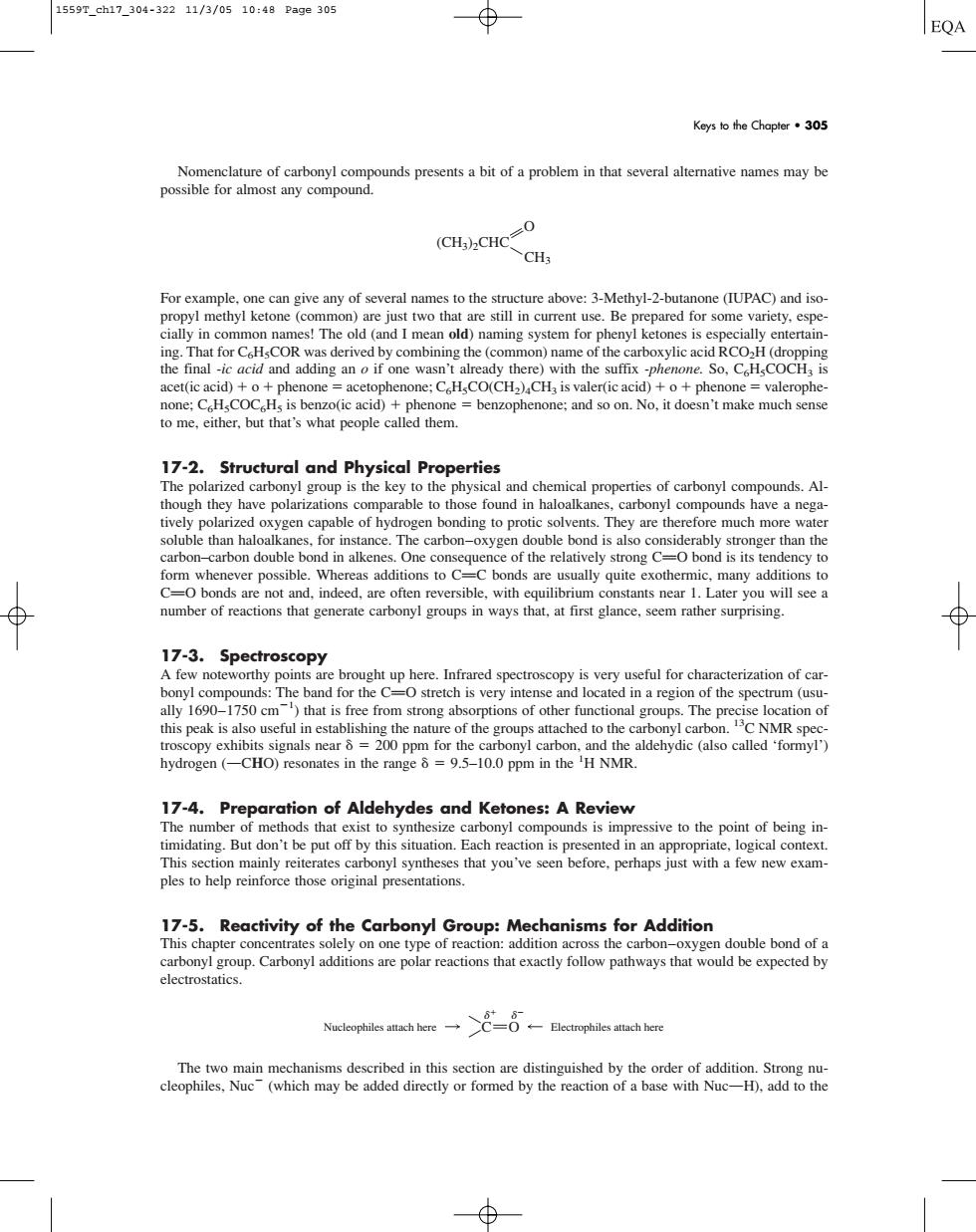正在加载图片...

1559Tch17304-32211/3/0510:48Page305 EQA Keys to the Chapter·3o5 CH For exampl to the s ebove-Mcthy--(AC)nd ommon m Tho (and I mean ld)naming system for pheny ketones is y combining the (common)name of the arboxylic acic acet(ic acid)+phenone=acctophenone:CCO(CH)CH is valer(ic acid)+phenone=valerophe- to me.either.butt 17-2.Structural and Physical Properties I group is the key and gen capable of hydrogen bonding to protic solvents.The are therefore much more water luble than hal n whenever possible.Whereas additions to C=C bonds are usually quite exothermic. many additions to 17-3.Spectroscopy 6ownotewornh P d for the groups.The e location of this peak is o usel in estab hing of the groups anached to spe hydrogen (CH)nat t rangePm thHNMR ation of Aldebydes and Keto 二密 17-5.Reactiv rity of th he Carbonyl Group:Mechanisms for Addition double bond of philes here The two main mechanisms described in this section are distinguished by the order of addition.Strong nu cleophiles.Nuc(which may be added directly or formed by the reaction of a base with Nuc-H).add to theNomenclature of carbonyl compounds presents a bit of a problem in that several alternative names may be possible for almost any compound. For example, one can give any of several names to the structure above: 3-Methyl-2-butanone (IUPAC) and isopropyl methyl ketone (common) are just two that are still in current use. Be prepared for some variety, especially in common names! The old (and I mean old) naming system for phenyl ketones is especially entertaining. That for C6H5COR was derived by combining the (common) name of the carboxylic acid RCO2H (dropping the final -ic acid and adding an o if one wasn’t already there) with the suffix -phenone. So, C6H5COCH3 is acet(ic acid) o phenone acetophenone; C6H5CO(CH2)4CH3 is valer(ic acid) o phenone valerophenone; C6H5COC6H5 is benzo(ic acid) phenone benzophenone; and so on. No, it doesn’t make much sense to me, either, but that’s what people called them. 17-2. Structural and Physical Properties The polarized carbonyl group is the key to the physical and chemical properties of carbonyl compounds. Although they have polarizations comparable to those found in haloalkanes, carbonyl compounds have a negatively polarized oxygen capable of hydrogen bonding to protic solvents. They are therefore much more water soluble than haloalkanes, for instance. The carbon–oxygen double bond is also considerably stronger than the carbon–carbon double bond in alkenes. One consequence of the relatively strong CPO bond is its tendency to form whenever possible. Whereas additions to CPC bonds are usually quite exothermic, many additions to CPO bonds are not and, indeed, are often reversible, with equilibrium constants near 1. Later you will see a number of reactions that generate carbonyl groups in ways that, at first glance, seem rather surprising. 17-3. Spectroscopy A few noteworthy points are brought up here. Infrared spectroscopy is very useful for characterization of carbonyl compounds: The band for the CPO stretch is very intense and located in a region of the spectrum (usually 1690–1750 cm1 ) that is free from strong absorptions of other functional groups. The precise location of this peak is also useful in establishing the nature of the groups attached to the carbonyl carbon. 13C NMR spectroscopy exhibits signals near 200 ppm for the carbonyl carbon, and the aldehydic (also called ‘formyl’) hydrogen (OCHO) resonates in the range 9.5–10.0 ppm in the 1 H NMR. 17-4. Preparation of Aldehydes and Ketones: A Review The number of methods that exist to synthesize carbonyl compounds is impressive to the point of being intimidating. But don’t be put off by this situation. Each reaction is presented in an appropriate, logical context. This section mainly reiterates carbonyl syntheses that you’ve seen before, perhaps just with a few new examples to help reinforce those original presentations. 17-5. Reactivity of the Carbonyl Group: Mechanisms for Addition This chapter concentrates solely on one type of reaction: addition across the carbon–oxygen double bond of a carbonyl group. Carbonyl additions are polar reactions that exactly follow pathways that would be expected by electrostatics. The two main mechanisms described in this section are distinguished by the order of addition. Strong nucleophiles, Nuc (which may be added directly or formed by the reaction of a base with NucOH), add to the C Nucleophiles attach here O Electrophiles attach here (CH3)2CHC CH3 O Keys to the Chapter • 305 1559T_ch17_304-322 11/3/05 10:48 Page 305��������